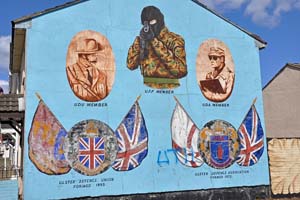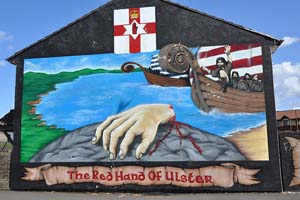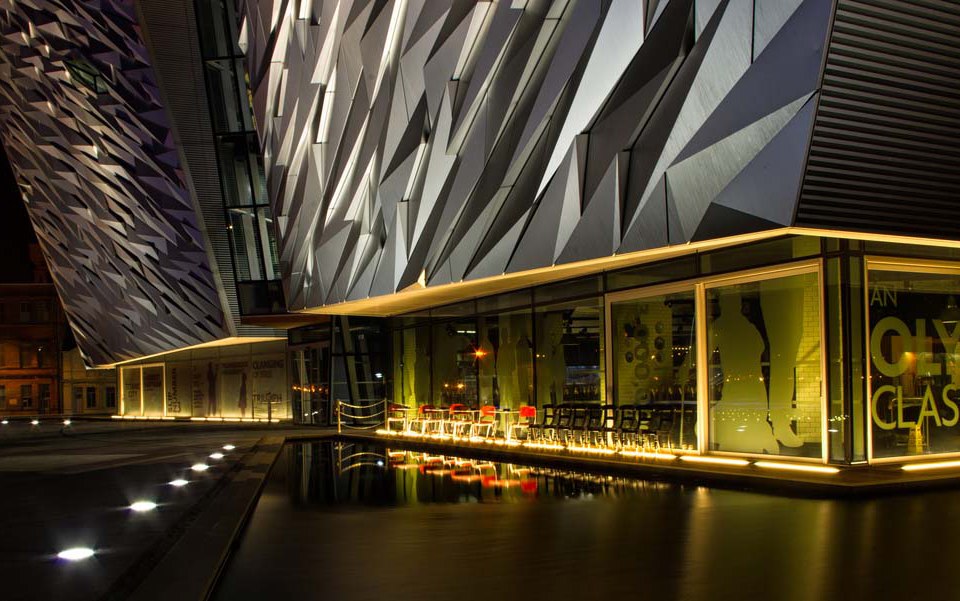The crowd wedged into Belfast’s famous Crown Liquor Saloon was in high spirits for 3 on a Saturday afternoon. As waitresses scurried around with steaming plates of fish and chips, Irish stew and champ, a creamy mashed potato-and-scallion dish, the bartenders poured pint after frothy pint of Guinness and ale. Peals of laughter floated up from customers tucked into the bar’s famous “snugs,” or enclosed booths,accenting the lively chatter echoing up and down the long, polished bar.
A diminutive Brit on holiday wedged his way next to me at the bar, anxious to retrieve the two dripping pints of ale the bartender had just set down. “Belfast is a great city, isn’t it?” he shouted to me over the din. “Now that The Troubles are over, it’s just a fantastic place to visit.”
Indeed. With more than a decade of peace under its belt and well over $1.5 billion of investment capital being poured into a dizzying array of new hotels, restaurants, bars and commercial enterprises, Belfast’s star isn’t merely rising, it’s rocketing to the heavens.
Back to the future
Not too long ago, small groups of Northern Ireland’s Protestants (Loyalists) and Catholics (Nationalists) were embroiled in a 30-year fight — The Troubles — over fealty to the U.K. versus the creation of a united Ireland. More than 3,600 died,includingmany innocent civilians, and nearly 30,000 British soldiers were stationed in Belfast alone to keep the peace. Tourism was nonexistent. But when residents in the Republic of Ireland and Northern Ireland overwhelmingly voted to accept the historic Good Friday Agreement of 1998, peace finally came to Belfast — and the city moved quickly to make up for lost time.
When I’d first arrived in town, I wanted to submerge myself in its shiny new buildings, crowded pubs and bustling shops. But I knew I first had to understand Belfast’s past. So instead I booked one of the city’s popular “black cab” tours of the main site of The Troubles, Shankill and Falls Roads. Billy Scott was my guide.
“Belfast was a ghost town before the Good Friday Agreement,” he said as we motored toward the once-troubled neighborhoods on the city’s west side.It was hard for me to imagine, as tourists were everywhere.
As we neared Shankill and Falls Roads, it was eerily easy to identify the past hotspots. Union Jacks still fluttered proudly in the Protestant sections, while Ireland’s green-and-orange flag waved from numerous perches throughout the Catholic sectors. And then there were the murals. Numbering approximately 500 during the terrorist reign, there are still 200-300 in the city today, many in these neighborhoods. Painted on the sides of homes, businesses and fences, the largely political murals can be menacing, like the Loyalist one of a black-hooded figure that appears to be aiming an Uzi straight at you, no matter how you look at it. (Locals call it the Mona Lisa, chuckled Scott.) Others commemorate fallen terrorist “heroes,” or plead the Nationalist or Loyalist cause.
Viewing the murals was intimidating. Did locals really appreciate tourists cruising by, snapping photos of murals commemorating a terrible, violent past that wasn’t even a generation old? But Scott said not to worry. “The Republican areas have always encouraged outsiders to come in and ask questions, because they want to tell their story,” he said. “In the past, the Loyalists wanted people to keep out and not interfere in their business. But now the Loyalists realize they have a story to tell, too, and that there’s no sense having murals if there’s no one to see them.”
Belfast is encouraging the creation of new murals today — ones celebrating their culture, not their political differences.
It’s a new day
Now I was ready to explore the Belfast of today. I started at the old Harland & Wolff shipyard on the River Lagan. Belfast was the world’s leading shipbuilding center at the start of the 20th century, and it was here that the mighty Titanic and her sister ships, the Olympic and Brittanic, were crafted.(Locals joke the Titanic was just fine when she left Belfast.)There’s no more shipbuilding in Belfast today,but the mammoth dry dock that cradled the Titanicduring portions of her construction remains.
The dry dock is part of the +185-acre Titanic Quarter, an urban-waterfront regeneration project currently underway that will eventually include more than 7,500 apartments, plus hotels, shops, offices, theaters, a 10,000-seat arena, a university campus and science park. Opened here in 2012: Titanic Belfast, a museum explaining the Titanic story.
I asked Scott to drop me off at the Belfast Wheel next, to enjoy a panoramic view of the city. But Scott drove me to Victoria Square instead. A newer commercial, residential and leisure development, its centerpiece is a massive glass dome rising 150 feet above the ground.“The view is just as good as from the Ferris wheel,” said Scott, “and it’s free. The Belfast Wheel will set you back six-and-a-half pounds.”
Up in the dome, I slowly walked around its circular interior and took in the city below. Green onion-domed turrets topped centuries-old stone buildings.I spied the Wheel, lazily turning around in its spot tucked next to Belfast’s ornate City Hall.
Not sure what to see next, I quizzed a local, Marty Mills. As Mills pondered my question, he mused aloud about the city’s past. “I remember when I was a kid and came downtown, there was a ring of steel around the city with only a few gates letting people in,” he said. “You were searched before you could get in, and you were searched for weapons and incendiary devices before you could enter a shop. Those were the bad old days.”
Mills decided I should stop in at the Crown Liquor Saloon. A riot of color and intricate designs, the +175-year-old bar features Victorian-etched windows, Italian tilework, an embossed ceiling and those popular wooden snugs, proudly decorated with gryphons and lions. It’s a famous city landmark. But the place was packed, so after my encounter with the Englishman, I decided to find another spot. A funky place calledMade in Belfastcaught my eye.
Waiter Edgar Jimenez quickly pegged me as a fellow American. I ordered an Irish coffee, noting I’d heard they tasted much better here than back home. Jimenez readily agreed. “It’s because they use Bushmill’s [triple-distilled Irish whiskey]here and real cream, which is different than the real cream back home,” he said, setting down a clear mug filled with a rich brown liquid topped with white froth. As I sipped my coffee — definitely better than in the States — Jimenez said my next stop should be Sandy Row, another historic Troubles spot.
Soon I was approaching a small enclave fronted by a huge mural defiantly proclaiming, “You are now entering Loyalist Sandy Row/Heartland of South Belfast/Ulster — Freedom Fighters.” A profusion ofUnion Jacks sprouted from the street’s buildings, while the curbing was painted the flag’s red, white and blue colors as far as the eye could see. Walking down the street, I was alarmed to spot a store named “Belfast Altercations.” Then I realized it was really a sewing shop named “Belfast Alterations.” How easy it was for me, an outsider, to get caught up in the past; how difficult it must be for those who lived it to move on. But, thankfully, they are.
Heading back to my hotel as Belfast’s night lights twinkled on, the already-bustling streets began swelling with even more carefree folks. Most likely, it will take residents a generation or two to truly put the past behind them. But there’s no doubt the city’s moving toward a bright future.



